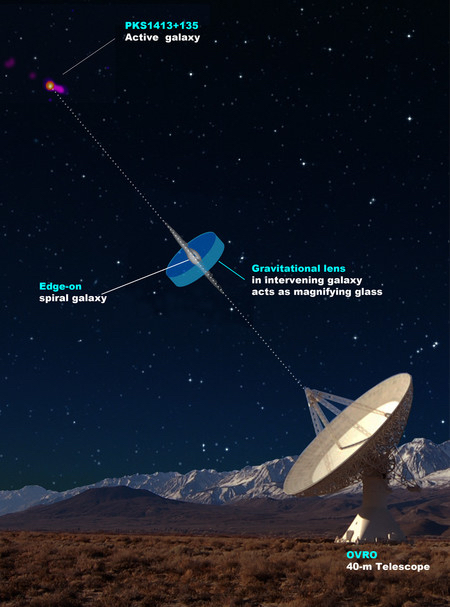Cosmic Magnifying Lens Reveals Inner Jets of Black Holes
An international team of astronomers, including Prof. Vasiliki Pavlidou of the Dept. of Physics of the Univ. of Crete have discovered a unique lensing system in space, in which a 10,000-solar-mass lens is magnifying a much more distant galaxy containing a jet-spewing supermassive black hole. The discovery provides the best view yet of blobs of hot gas that are shot outward from supermassive black holes.
Many supermassive black holes at the centers of galaxies blast out jets of gas traveling near the speed of light. The gravity of black holes pulls material toward them, but some of that material ends up ejected away from the black hole in jets. The jets are active for one to 10 million years—every few years, they spit out additional clumps of hot material. With the new gravitational lensing system, these clumps can be seen at scales about 100 times smaller than before – with a resolution of a millionth of a second of arc, which is equivalent to viewing a grain of salt on the moon from Earth.

A critical element of this lensing system is the lens itself. If confirmed, this would be the first lens of "intermediate" mass—which means that it is bigger than previously observed "micro" lenses consisting of single stars and smaller than the well-studied massive lenses as big as galaxies. The lens, dubbed a "milli-lens," is thought to be about 10,000 solar masses. It is likely a cluster of stars, but it could also be a dark-matter agglomerate.
An advantage of the milli-sized lens is that it is small enough not to block the entire source, which allows the jet clumps to be magnified and viewed as they travel, one by one, behind the lens. What's more, the lens itself is of scientific interest because not much is known about objects of this intermediate-mass range.
The new observations are part of Caltech's Owens Valley Radio Observatory (OVRO) program to obtain twice-weekly images of 1,800 active supermassive black holes and their host galaxies, using OVRO's 40-meter telescope, which detects radio emissions from celestial objects. The program has been running since 2008 in support of NASA's Fermi mission, which observes the same galaxies in higher-energy gamma rays.
In 2010, the OVRO researchers noticed something unusual happening with an active galaxy called PKS 1413+ 135. Its radio emission had brightened, faded, and then brightened again in a very symmetrical fashion over the course of a year. The same type of event happened again in 2015. After a careful analysis that ruled out other scenarios, the researchers concluded that the overall brightening of the galaxy is most likely due to two successive high-speed clumps ejected by the galaxy's black hole a few years apart. The clumps traveled along the jet and became magnified when they passed behind the milli-lens.

The international research team was led by Anthony Readhead (emeritus Professor at Caltech and a collaborator on many University of Crete key projects, including RoboPol and PASIPHAE, and it included University of Crete faculty Vasiliki Pavlidou, who has been a member of the OVRO collaboration since 2008.
Other collaborators of this work include Harish Vedantham (the lead author), Timothy Pearson and Vikram Ravi of Caltech, Walter Max-Moerbeck and Anton Zensus of the Max Planck Institute for Radio Astronomy; Talvikki Hovatta of University of Turku and the Aalto University Metsähovi Radio Observatory; Anne Lähteenmäki and Merja Tornikoski of the Aalto University Metsähovi Radio Observatory; Mark Gurwell of the Smithsonian Astrophysical Observatory; Roger Blandford of Stanford University; and Rodrigo Reeves of the University of Concepción.
Articles: “Symmetric Achromatic Variability in Active Galaxies: A Powerful New Gravitational Lensing Probe?” by Vedantham et al. The Astrophysical Journal, 845, 89, and "The Peculiar Light Curve of J1415 + 1320: A Case Study in Extreme Scattering Events" by Vedantham et al. 2017, The Astrophysical Journal, 845, 90
More information is also available in the orginal Caltech Press Release.




